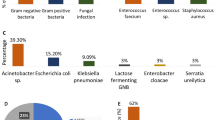Abstract
Objectives
Patients with liver cirrhosis are at increased risk for fungal infections. However, distinction of fungal colonisation (FC) and invasive mycoses is difficult. Aim of this study was to analyse the impact of FC on mortality of cirrhotic ICU-patients.
Methods
Retrospective mortality analysis of a prospectively maintained database on 120 cirrhotic patients with and without FC. Comparison to 120 noncirrhotic controls matched for APACHE-II (24.9 ± 3.7 vs. 25.0 ± 2.6; p = 0.263).
Results
About 69/120 (58 %) of patients with cirrhosis had FC. These patients had significantly higher APACHE-II score and mortality compared to cirrhotic patients without FC (27 ± 3 vs. 23 ± 4, p < 0.001; 78 vs. 35 %, p < 0.001). In multivariate analysis, FC was independently (p = 0.047) associated to mortality. Mortality of noncirrhotic patients with FC (14/31; 45.2 %) was not different to noncirrhotic controls without FC [28/89 (31.2 %; p = 0.168)]. Similarly, in multivariate analysis of noncirrhotics, APACHE-II (p < 0.001), but not FC, was independently associated to mortality. Multiple regression analysis of all 240 cirrhotic and noncirrhotic patients demonstrated that APACHE-II (p < 0.001), cirrhosis (p = 0.001) and FC (p = 0.049) were independently associated with mortality.
Conclusion
Fungal “colonisation” is independently associated to mortality in cirrhotic ICU-patients. Early antimycotic therapy should be considered in critically ill cirrhotic patients with FC.



Similar content being viewed by others
References
Donnelly JP. Symptoms and diagnosis of nosocomial fungal infections -state-of-the-art. Eur J Med Res. 2002;31:192–9.
Hsu JL, Ruoss SJ, Bower ND, Lin M, Holodniy M, Stevens DA. Diagnosing invasive fungal disease in critically ill patients. Crit Rev Microbiol. 2011;37:277–312.
Bonnel AR, Bunchorntavakul C, Reddy KR. Immune dysfunction and infections in patients with cirrhosis. Clin Gastroenterol Hepatol. 2011;9:727–38.
Tortorano AM, Dho G, Prigitano A, et al. ECMM-FIMUA Study Group invasive fungal infections in the intensive care unit: a multicentre, prospective, observational study in Italy (2006–2008). Mycoses. 2012;55:73–9.
Pittet D, Monod M, Suter PM, Frenk E, Auckenthaler R. Candida colonization and subsequent infections in critically ill surgical patients. Ann Surg. 1994;220(6):751–8.
Leroy G, Lambiotte F, Thévenin D, et al. Evaluation of “Candida score” in critically ill patients: a prospective, multicenter, observational, cohort study. Ann Intensive Care. 2011;1(1):50.
Iber FL. Patients with cirrhosis and liver failure are at risk for bacterial and fungus infection. Am J Gastroenterol. 1999;94:2001–3.
Rolando N, Philpott-Howard J, Williams R. Bacterial and fungal infection in acute liver failure. Semin Liver Dis. 1996;16:389–402.
Dellinger RP, Levy MM, Rhodes A, et al. Surviving sepsis campaign: international guidelines for management of severe sepsis and septic shock, 2012. Intensive Care Med. 2013;39(2):165–228.
Kumar A, Safdar N, Kethireddy S, Chateau D. A survival benefit of combination antibiotic therapy for serious infections associated with sepsis and septic shock is contingent only on the risk of death: a meta-analytic/meta-regression study. Crit Care Med. 2010;38(8):1651–64.
O’Brien J, Triantos C, Burroughs AK. Management of varices in patients with cirrhosis. Nat Rev Gastroenterol Hepatol. 2013;10(7):402–12.
Gustot T, Durand F, Lebrec D, et al. Severe sepsis in cirrhosis. Hepatology. 2009;50(6):2022–33.
Marchetti O, Eggimann P, Calandra T. Invasive candidiasis in critically ill patients: does progressing knowledge improve clinical management and outcome? Curr Opin Crit Care. 2010;16:442–4.
Vazquez JA. Invasive fungal infections in the intensive care unit. Semin Respir Crit Care Med. 2010;31:79–86.
Pemán J, Zaragoza R. Current diagnostic approaches to invasive candidiasis in critical care settings. Mycoses. 2010;53:424–33.
Choi SH, Soo Kim Y, Chung JW, et al. Clinical significance of untreated Candida species isolated from ascites in cirrhotic patients. Scand J Infect Dis. 2004;9:649–55.
Navasa M, Rimola A, Rodes J. Bacterial infections in liver disease. Semin Liver Dis. 1997;17:323–33.
Yazıcıoğlu Moçin O, Karakurt Z, Aksoy F et al. Bronchoscopy as an indicator of tracheobronchial fungal infection in non-neutropenic intensive-care unit patients. Clin Microbiol Infect. 2013; 19(3):E136–41.
Falcone M, Massetti AP, Russo A, Vullo V, Venditti M. Invasive aspergillosis in patients with liver disease. Med Mycol. 2011;49:406–13.
Prodanovic H, Cracco C, Massard J, et al. Invasive pulmonary aspergillosis in patients with decompensated cirrhosis: case series. BMC Gastroenterol. 2007;31:2.
Charles PE, Castro C, Ruiz-Santana S, León C, Saavedra P, Martín E. Serum procalcitonin levels in critically ill patients colonized with Candida spp: new clues for the early recognition of invasive candidiasis? Intensive Care Med. 2009;35:2146–50.
Badiee P, Alborzi A, Joukar M. Molecular assay to detect nosocomial fungal infections in intensive care units. Euro J Intern Med. 2011;22:611–5.
Badiee P, Alborzi A, Joukar M. Molecular assay to detect nosocomial fungal infections in intensive care units. Eur J Intern Med. 2011;22:611–5.
Lipke AB, Mihas AA. Non-decompensated cirrhosis as a risk factor for invasive aspergillosis: a case report and review of the immune dysfunction of cirrhosis. Am J Med Sci. 2007;334:314–6.
Echeverria PM, Kett DH, Azoulay E. Candida prophylaxis and therapy in the ICU. Semin Respir Crit Care Med. 2011;32:159–73.
Falcone M, Massetti AP, Russo A, Vullo V, Venditti M. Invasive aspergillosis in patients with liver disease. Med Mycol. 2011;4:406–13.
Conflict of interest
None of the authors has any potential financial conflict of interest related to this manuscript.
Author information
Authors and Affiliations
Corresponding author
Additional information
Tobias Lahmer and Marlena Messer have equally contributed to this article.
Rights and permissions
About this article
Cite this article
Lahmer, T., Messer, M., Mayr, U. et al. Fungal “colonisation” is Associated with Increased Mortality in Medical Intensive Care Unit Patients with Liver Cirrhosis. Mycopathologia 179, 63–71 (2015). https://doi.org/10.1007/s11046-014-9825-6
Received:
Accepted:
Published:
Issue Date:
DOI: https://doi.org/10.1007/s11046-014-9825-6




